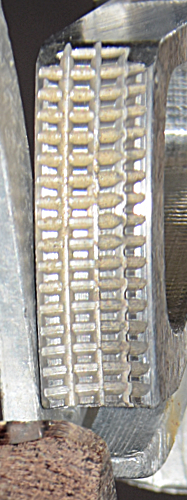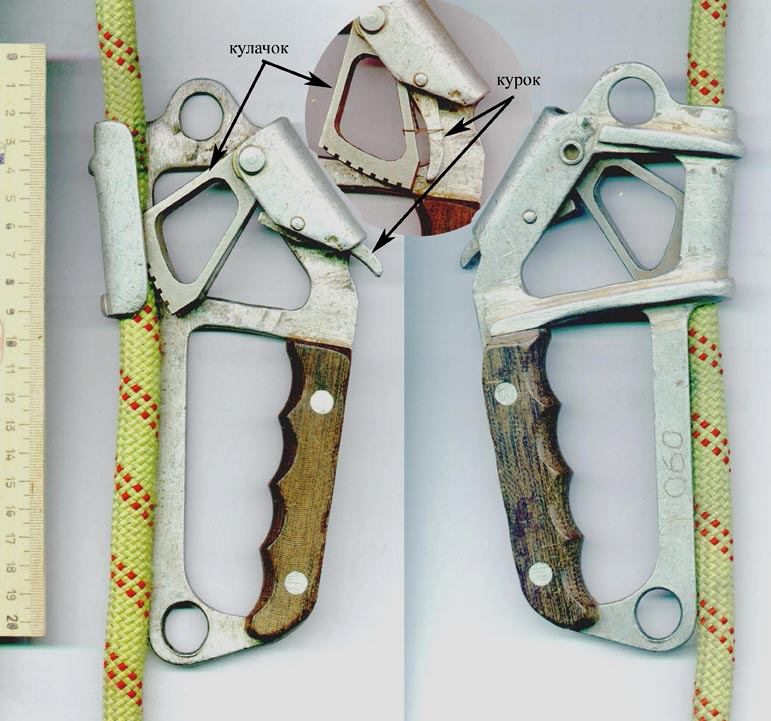Technical Details
 I acquired this ascender from Sarah Conner in 2016.
I acquired this ascender from Sarah Conner in 2016.
This ascender is 208 mm. tall, 103 mm. wide, 26 mm. thick, and weighs 237 g.
The shell is a tall irregular shaped stamping formed from 3.9 mm. aluminum alloy sheet metal. A 17 mm. wide rope channel is formed in the upper portion of one side and a smaller cam channel lies opposite the first. A hole drilled through both sides of the cam channel accepts a 6.4 mm. rivet. The cam and cam spring are mounted on this rivet. The handle below the cam has a textolite hand grip riveted into place. A 14.6 mm. by 16.8 mm. sling attachment hole is cut below the handle opening. A 13.9 mm. by 17.3 mm hole above the cam provides an upper attachment point.
The cam is milled from D-16 Duralumin. The cam radius increases from 45 to 58 mm. over an angle of 40°, giving a 20° cam angle. The cam has number of milled teeth. The tooth pattern is (2)(4)^17.
The cam safety is a crudely machined aluminum lever mounted, along with a safety spring and a spacer, on a 2.8 mm. rivet in the same shell channel as the cam. Normally the spring holds the safety where it blocks the cam from opening. When the end of the safety lever is depressed, the opposite end pivots upwards so that the cam is no longer obstructed.
There are no markings on this ascender.
I asked the seller about the history behind this ascender, but her reply was "I do not know who made this or how old it is." Comparing it to other ascenders that I'm familiar with, I suspected that it was a home-made copy of a Russian ascender - no other ascenders in my collection matched this one’s frame design like that one does.
 I learned more when in 2021, Артём Бабин sent me a copy of АССОЦИАЦИЯ СПЕЛЕОЛОГОВ УРАЛА СПЕЛЕО СНАРЯЖЕНИЕ Коллекция секции ВИВ (1963-1990 годы) фотоальбом (часть 1)[1]. Page 19 describes this ascender. Translated, it says,
I learned more when in 2021, Артём Бабин sent me a copy of АССОЦИАЦИЯ СПЕЛЕОЛОГОВ УРАЛА СПЕЛЕО СНАРЯЖЕНИЕ Коллекция секции ВИВ (1963-1990 годы) фотоальбом (часть 1)[1]. Page 19 describes this ascender. Translated, it says,
"Clips made by climbers of the Molot?…
"They copied Petzl’s grandfather soundly, having come up with their own trigger design, but the cam was usual, with a milled mesh on its smooth working surface. As a result, it does not hold, even on a dry rope. Bearing in mind the low strength of the prototype when pulling the handle, the hull was reinforced with two stiffeners welded to the body.
"Materials: Case: - Aluminum 4mm thick; Cam, trigger: - duralumin D-16 Overlays - textolite 8mm thick.… Weight - 240g."
Mine does not have the added reinforcing.
The hand opening is tall enough for my hands. Although it doesn't score well with the test blocks that I use on the Ascender Handles page, it fits comfortably in my hand. So much for arbitrary criteria!
The safety is easy to use with one hand, and this is perhaps the easiest handled ascenders to operate single-handed that I own. The opening behind the cam provides easy access for the right-hand index finger. This makes it easier to open this ascender with the right hand than, say the right-handed Clogs that use the same type safety.
The cam teeth are nicely milled; however, without sharp teeth to dig into the rope, the cam slips rather easily.
__________
[1] ASSOCIATION OF SPELEOLOGISTS OF THE URALS SPELEO EQUIPMENT VIV section collection (1963-1990 years) photo album (part 1) © Evdokimov S.S. PERM-2009, Publishing Commission of ACS (Association of Cavers of the Urals).



